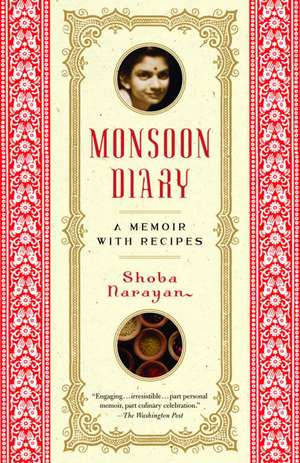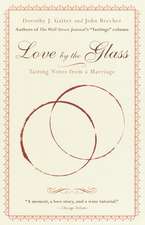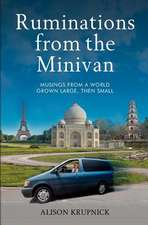Monsoon Diary: A Memoir with Recipes
Autor Shoba Narayanen Limba Engleză Paperback – 31 mar 2004
Vezi toate premiile Carte premiată
Narayan recounts her childhood in South India, her college days in America, her arranged marriage, and visits from her parents and in-laws to her home in New York City. Monsoon Diary is populated with characters like Raju, the milkman who named his cows after his wives; the iron-man who daily set up shop in Narayan’s front yard, picking up red-hot coals with his bare hands; her mercurial grandparents and inventive parents. Narayan illumines Indian customs while commenting on American culture from the vantage point of the sympathetic outsider. Her characters, like Narayan herself, have a thing or two to say about cooking and about life.
In this creative and intimate work, Narayan’s considerable vegetarian cooking talents are matched by stories as varied as Indian spices—at times pungent, mellow, piquant, and sweet. Tantalizing recipes for potato masala, dosa, and coconut chutney, among others, emerge from Narayan’s absorbing tales about food and the solemn and quirky customs that surround it.
Preț: 99.30 lei
Nou
Puncte Express: 149
Preț estimativ în valută:
19.00€ • 19.91$ • 15.71£
19.00€ • 19.91$ • 15.71£
Carte disponibilă
Livrare economică 22 martie-05 aprilie
Preluare comenzi: 021 569.72.76
Specificații
ISBN-13: 9780812971071
ISBN-10: 0812971078
Pagini: 240
Ilustrații: 3 BLACK-&-WHITE PHOTOS
Dimensiuni: 134 x 204 x 14 mm
Greutate: 0.18 kg
Editura: Random House Trade
ISBN-10: 0812971078
Pagini: 240
Ilustrații: 3 BLACK-&-WHITE PHOTOS
Dimensiuni: 134 x 204 x 14 mm
Greutate: 0.18 kg
Editura: Random House Trade
Notă biografică
SHOBA NARAYAN has written for Travel & Leisure, Gourmet, Saveur, Food & Wine, Newsweek, House Beautiful, The New York Times, and The Wall Street Journal. She is a regular guest on NPR’s All Things Considered Weekend and a recipient of the M.F.K. Fisher Award for Distinguished Writing, given by the James Beard Foundation. Narayan graduated from the Columbia Graduate School of Journalism, which awarded her a Pulitzer Fellowship. She lives in New York City with her husband and two children. Her website is www.shobanarayan.com.
Extras
Chapter One
First Foods
The first foods that I ate were rice and ghee. I know this because my mother told me so. I was six months old, and as was traditional, my parents conducted a formal choru-unnal ceremony at the famous Guruvayur temple in Kerala.
Choru-unnal literally means "rice-eating," and the ceremony marks the first meal of a child. Typically, this is done in the presence of a priest who recites Sanskrit mantras while the parents, grandparents, and relatives tease morsels of mashed rice into the child's mouth. Few Indians speak Sanskrit anymore, and most don't understand what the mantras mean. Since the mantras are considered sacred, it is presumed that they will nudge the baby into a lifetime of healthful eating. This particular presumption must be wrong, for I know of no Indian child with good eating habits.
Indian mothers are obsessed with feeding their children, and perhaps as a result Indian kids don't eat well. When I attend parties with American families, mealtimes seem so civilized and quiet. The mothers cut up a piece of meat or a pizza into small pieces, and the kids obligingly fork it in.
Compare that with an Indian party. Mothers follow their kids around, hands outstretched with food, entreating them to eat. Fathers balance plates of food in one hand and, with the other, try to grasp crawling babies intent on escaping. Clearly, the sacred mantras have not made one iota of difference in the children's attitude toward food. Still, having a chanting priest at any Hindu rite of passage is de rigueur, and my family, traditional as it was, complied.
My parents had chosen the Krishna temple at Guruvayur for reasons both practical and sentimental. They each had had their own rice-eating ceremony there. The temple's central location made it convenient for my grandparents, aunts, and uncles to attend. More important, my parents liked the "pure" ambience of the temple, which admitted only Hindus into its portals, and only those that followed its strict dress code. The women had to wear saris, and the men had to remove their shirts as a mark of respect for the deity. My parents were especially delighted by the fact that the temple kept out all foreigners, even those camera-toting tourists who thought they could gain admission into ancient temples by waving a few dollars. While such bribes may have worked in other temples, not so in Guruvayur, they remarked approvingly.
On the practical side, my father had vowed to conduct a thula bharam at the temple to give thanks for my safe delivery. My parents thought that they could accomplish both events-the choru-unnal and the thula bharam-with one trip.
The thula bharam is an offering to God. In a corner of the temple was a giant scale (thula), behind which was a blackboard that listed various offerings: bananas, jaggery (unprocessed raw sugar), gold, silver, coconuts, and even water. Devotees could pick any one of the offerings, weigh themselves against it, and pay by the kilo for their choice.
Corrupt politicians would sit on one scale, while the temple staff loaded up the other with silver. When the scales were balanced, the politician would pay for his weight in silver and hope to wash away his sins. Corpulent gold merchants from Bombay-and they were almost always corpulent-would sit placidly on one scale and pay for the equivalent weight of gold with "black money" that didn't make it to their tax books. Poor people who could afford little else would weigh themselves against water and pay their pittance to God, who, we children were told, viewed every offering with a benevolent eye. My father, a college professor just embarking on his career, sensibly chose bananas, which were in the middle of the price chart, above water, jaggery, and coconuts but much below gold and silver. He weighed himself against a bunch of bananas and paid for his bharam (weight).
The choru-unnal ceremony was next. All these religious rites were conducted in the outer sanctum, a vast space with cobblestone floors, granite walls, and carved pillars. Women in pristine white saris and dripping wet hair circled the temple muttering prayers; wandering mendicants with matted hair and saffron robes hobbled around; schoolchildren smeared sandalwood paste on their foreheads and chased one another from pillar to post. Against this busy backdrop, my family adjourned to a corner where I was to be fed for the first time. My grandmother held me in her lap while my parents converged around and made faces at me. I know this because it is what parents do when confronted with their newborn child.
A baby can do something as mundane as stick her tongue out and the proud parents will read profound meaning into the action. "Look, she is sucking her lips in anticipation of the food," they will say.
Grandparents go a step further; they view the baby's actions as a reflection of their gene pool. "After all, she is my granddaughter," they will say. "Of course she knows that food is coming."
The priest solemnly placed a sliver of ghee rice in my mouth. I promptly spat. Everyone went still.
"Let me taste the food," my mother demanded. She did so and pulled a face. "The ghee is burnt," she said. "No wonder my daughter spit up."
The priest began to protest, but my family would have none of it. Their first child wasn't going to eat burnt food for her first meal. The temple would kindly make some fresh ghee for the infant's meal. They would be happy to wait.
So we waited. My parents gazed adoringly at me as I blew bubbles with my spit. The priest swatted flies. My grandparents tried to get their brand-new camera, bought for the occasion, to work. Temple officials arrived and informed my parents that they had tested the ghee and it wasn't burnt, but they were going to make a fresh batch because my parents had insisted. Of course it would cost them double.
Half an hour later, fresh ghee arrived. The priest mixed it with rice, my mother tested it and slipped it into my mouth. This time I rolled it around with my tongue. My parents watched anxiously.
Another idea that afflicts new parents is the notion that their newborn is never wrong.
"See?" my mother remarked triumphantly when I eventually swallowed. "It wasn't my daughter's fault. It was the food."
I rest my case.
I visited many temples as a child, mostly because my parents dragged me to them. Like all children, I viewed religion as a chore, a necessary hindrance that punctuated my beatific existence with its endless choices and boundless confidence. It is only recently that I have turned to religion for solace and sustenance. This, I suppose, is the process of growing up, of pondering life's imponderables and acknowledging one's limitations.
As a child, after a long morning of prostrating myself before multiple deities, I would stand in line for the prasadam-food that is presented to God and then distributed to the devotees-which in my mind was the best part of the visit. Each temple had a specialty. The Tirupati temple, where devotees shaved their hair and offered it to God as a symbol of their vanity, made excellent laddus (candied balls). The Guruvayur temple served thick payasam, a gooey combination of rice, milk, and sugar stirred slowly over an open fire by Brahmin priests until it turned light yellow. The Muruga temple in Palani was known for its panchamritham (five nectars), made with crystal sugar, honey, ghee, cardamom, and bananas. Some temples distributed sweet pongal folded within banana leaves. Others, a mixture of raisins, nuts, and coconut flakes. All of them used copious quantities of ghee.
Ghee (clarified butter) is one of the most highly regarded foods in Indian cuisine. While modern Indians dismiss it as being "fatty," the ancients used to drink a teaspoon of warm ghee with every meal.
It is one of the easiest things to cook, but also the easiest to mess up. Making ghee is all about timing. The trick is to remove it from the fire at the exact moment when it turns golden brown. A minute extra could turn it black and imbue it with a burnt smell. Removing it from the fire early gives it a raw, buttery flavor, instead of the distinct fragrance of fresh ghee. Once the ghee is poured out, all that remains are its black dregs at the bottom of the pan.
As children, we would mix hot rice with the black dregs and gobble it down. This "black rice" had the flavor and taste of ghee and was also an Indian method of not wasting even a single ounce of the precious butter from which ghee is made.
A mixture of equal parts ghee, crushed fresh ginger, and brown sugar is an age-old recipe believed to improve digestion.
ghee
Ghee is the vegetarian's caviar: slightly sinful, somewhat excessive, but oh so delicious. For Indians, ghee offers the same rich-if guilty-pleasures that chocolates do for the dieter. My sister-in-law Priya is known far and wide as an exceptional cook. She says that just a teaspoon of ghee makes all the difference in flavor-like ice cream versus fat-free sorbet. While Indians may skimp on ghee in their daily life, they go overboard when it comes to ghee sweets.
Bus travel through Rajasthan, Maharashtra, and most other North Indian states affords the particular pleasure of eating hot rotis (flat breads) made right before one's eyes at tiny roadside stalls and served on banyan leaves with a dash of hot ghee on top. These rotis are made from different grains-bajra, jowar, ragi-each with its own distinctive taste. But they are all topped with ghee.
Ghee keeps at room temperature for about two months, longer in the winter. It should be used like a condiment, in small quantities. Indians typically brush ghee on their breads, spoon it into rice, or stir it into their soups.
makes about 1/2 cup
2 sticks (1 cup) unsalted butter, cut into 1-inch pieces
1.Bring butter to a boil in a small heavy saucepan over medium heat.
2.Once foam completely covers the butter, reduce the heat to very low. Cook, stirring occasionally, until a thin crust begins to form on the surface and milky white solids fall to bottom of pan, about 8 minutes.
3.Continue to cook, watching constantly and stirring occasionally to prevent burning, until the solids turn light brown and the butter deepens to golden and turns translucent and fragrant, about 3 minutes.
4.When the ghee stops bubbling, you can safely assume that it's done. Remove it from the heat, let it cool, and pour it into a jar.
From the Hardcover edition.
First Foods
The first foods that I ate were rice and ghee. I know this because my mother told me so. I was six months old, and as was traditional, my parents conducted a formal choru-unnal ceremony at the famous Guruvayur temple in Kerala.
Choru-unnal literally means "rice-eating," and the ceremony marks the first meal of a child. Typically, this is done in the presence of a priest who recites Sanskrit mantras while the parents, grandparents, and relatives tease morsels of mashed rice into the child's mouth. Few Indians speak Sanskrit anymore, and most don't understand what the mantras mean. Since the mantras are considered sacred, it is presumed that they will nudge the baby into a lifetime of healthful eating. This particular presumption must be wrong, for I know of no Indian child with good eating habits.
Indian mothers are obsessed with feeding their children, and perhaps as a result Indian kids don't eat well. When I attend parties with American families, mealtimes seem so civilized and quiet. The mothers cut up a piece of meat or a pizza into small pieces, and the kids obligingly fork it in.
Compare that with an Indian party. Mothers follow their kids around, hands outstretched with food, entreating them to eat. Fathers balance plates of food in one hand and, with the other, try to grasp crawling babies intent on escaping. Clearly, the sacred mantras have not made one iota of difference in the children's attitude toward food. Still, having a chanting priest at any Hindu rite of passage is de rigueur, and my family, traditional as it was, complied.
My parents had chosen the Krishna temple at Guruvayur for reasons both practical and sentimental. They each had had their own rice-eating ceremony there. The temple's central location made it convenient for my grandparents, aunts, and uncles to attend. More important, my parents liked the "pure" ambience of the temple, which admitted only Hindus into its portals, and only those that followed its strict dress code. The women had to wear saris, and the men had to remove their shirts as a mark of respect for the deity. My parents were especially delighted by the fact that the temple kept out all foreigners, even those camera-toting tourists who thought they could gain admission into ancient temples by waving a few dollars. While such bribes may have worked in other temples, not so in Guruvayur, they remarked approvingly.
On the practical side, my father had vowed to conduct a thula bharam at the temple to give thanks for my safe delivery. My parents thought that they could accomplish both events-the choru-unnal and the thula bharam-with one trip.
The thula bharam is an offering to God. In a corner of the temple was a giant scale (thula), behind which was a blackboard that listed various offerings: bananas, jaggery (unprocessed raw sugar), gold, silver, coconuts, and even water. Devotees could pick any one of the offerings, weigh themselves against it, and pay by the kilo for their choice.
Corrupt politicians would sit on one scale, while the temple staff loaded up the other with silver. When the scales were balanced, the politician would pay for his weight in silver and hope to wash away his sins. Corpulent gold merchants from Bombay-and they were almost always corpulent-would sit placidly on one scale and pay for the equivalent weight of gold with "black money" that didn't make it to their tax books. Poor people who could afford little else would weigh themselves against water and pay their pittance to God, who, we children were told, viewed every offering with a benevolent eye. My father, a college professor just embarking on his career, sensibly chose bananas, which were in the middle of the price chart, above water, jaggery, and coconuts but much below gold and silver. He weighed himself against a bunch of bananas and paid for his bharam (weight).
The choru-unnal ceremony was next. All these religious rites were conducted in the outer sanctum, a vast space with cobblestone floors, granite walls, and carved pillars. Women in pristine white saris and dripping wet hair circled the temple muttering prayers; wandering mendicants with matted hair and saffron robes hobbled around; schoolchildren smeared sandalwood paste on their foreheads and chased one another from pillar to post. Against this busy backdrop, my family adjourned to a corner where I was to be fed for the first time. My grandmother held me in her lap while my parents converged around and made faces at me. I know this because it is what parents do when confronted with their newborn child.
A baby can do something as mundane as stick her tongue out and the proud parents will read profound meaning into the action. "Look, she is sucking her lips in anticipation of the food," they will say.
Grandparents go a step further; they view the baby's actions as a reflection of their gene pool. "After all, she is my granddaughter," they will say. "Of course she knows that food is coming."
The priest solemnly placed a sliver of ghee rice in my mouth. I promptly spat. Everyone went still.
"Let me taste the food," my mother demanded. She did so and pulled a face. "The ghee is burnt," she said. "No wonder my daughter spit up."
The priest began to protest, but my family would have none of it. Their first child wasn't going to eat burnt food for her first meal. The temple would kindly make some fresh ghee for the infant's meal. They would be happy to wait.
So we waited. My parents gazed adoringly at me as I blew bubbles with my spit. The priest swatted flies. My grandparents tried to get their brand-new camera, bought for the occasion, to work. Temple officials arrived and informed my parents that they had tested the ghee and it wasn't burnt, but they were going to make a fresh batch because my parents had insisted. Of course it would cost them double.
Half an hour later, fresh ghee arrived. The priest mixed it with rice, my mother tested it and slipped it into my mouth. This time I rolled it around with my tongue. My parents watched anxiously.
Another idea that afflicts new parents is the notion that their newborn is never wrong.
"See?" my mother remarked triumphantly when I eventually swallowed. "It wasn't my daughter's fault. It was the food."
I rest my case.
I visited many temples as a child, mostly because my parents dragged me to them. Like all children, I viewed religion as a chore, a necessary hindrance that punctuated my beatific existence with its endless choices and boundless confidence. It is only recently that I have turned to religion for solace and sustenance. This, I suppose, is the process of growing up, of pondering life's imponderables and acknowledging one's limitations.
As a child, after a long morning of prostrating myself before multiple deities, I would stand in line for the prasadam-food that is presented to God and then distributed to the devotees-which in my mind was the best part of the visit. Each temple had a specialty. The Tirupati temple, where devotees shaved their hair and offered it to God as a symbol of their vanity, made excellent laddus (candied balls). The Guruvayur temple served thick payasam, a gooey combination of rice, milk, and sugar stirred slowly over an open fire by Brahmin priests until it turned light yellow. The Muruga temple in Palani was known for its panchamritham (five nectars), made with crystal sugar, honey, ghee, cardamom, and bananas. Some temples distributed sweet pongal folded within banana leaves. Others, a mixture of raisins, nuts, and coconut flakes. All of them used copious quantities of ghee.
Ghee (clarified butter) is one of the most highly regarded foods in Indian cuisine. While modern Indians dismiss it as being "fatty," the ancients used to drink a teaspoon of warm ghee with every meal.
It is one of the easiest things to cook, but also the easiest to mess up. Making ghee is all about timing. The trick is to remove it from the fire at the exact moment when it turns golden brown. A minute extra could turn it black and imbue it with a burnt smell. Removing it from the fire early gives it a raw, buttery flavor, instead of the distinct fragrance of fresh ghee. Once the ghee is poured out, all that remains are its black dregs at the bottom of the pan.
As children, we would mix hot rice with the black dregs and gobble it down. This "black rice" had the flavor and taste of ghee and was also an Indian method of not wasting even a single ounce of the precious butter from which ghee is made.
A mixture of equal parts ghee, crushed fresh ginger, and brown sugar is an age-old recipe believed to improve digestion.
ghee
Ghee is the vegetarian's caviar: slightly sinful, somewhat excessive, but oh so delicious. For Indians, ghee offers the same rich-if guilty-pleasures that chocolates do for the dieter. My sister-in-law Priya is known far and wide as an exceptional cook. She says that just a teaspoon of ghee makes all the difference in flavor-like ice cream versus fat-free sorbet. While Indians may skimp on ghee in their daily life, they go overboard when it comes to ghee sweets.
Bus travel through Rajasthan, Maharashtra, and most other North Indian states affords the particular pleasure of eating hot rotis (flat breads) made right before one's eyes at tiny roadside stalls and served on banyan leaves with a dash of hot ghee on top. These rotis are made from different grains-bajra, jowar, ragi-each with its own distinctive taste. But they are all topped with ghee.
Ghee keeps at room temperature for about two months, longer in the winter. It should be used like a condiment, in small quantities. Indians typically brush ghee on their breads, spoon it into rice, or stir it into their soups.
makes about 1/2 cup
2 sticks (1 cup) unsalted butter, cut into 1-inch pieces
1.Bring butter to a boil in a small heavy saucepan over medium heat.
2.Once foam completely covers the butter, reduce the heat to very low. Cook, stirring occasionally, until a thin crust begins to form on the surface and milky white solids fall to bottom of pan, about 8 minutes.
3.Continue to cook, watching constantly and stirring occasionally to prevent burning, until the solids turn light brown and the butter deepens to golden and turns translucent and fragrant, about 3 minutes.
4.When the ghee stops bubbling, you can safely assume that it's done. Remove it from the heat, let it cool, and pour it into a jar.
From the Hardcover edition.
Recenzii
“Shoba Narayan is that rarity in the food world: She has both a unique story and the lyrical skills to tell it.”
—Regina Schrambling, New York Times and Los Angeles Times food writer
“A taste of a life that is exotic yet familiar, Monsoon Diary is as pungent and satisfying as a good curry. Reading it made me want to get on a plane to India—or at least eat in an Indian restaurant.” —Sharon Boorstin, author of Let Us Eat Cake: Adventures in Food and Friendship
“An entirely enchanting look at growing up in South India, in an exotic world populated by the flower woman, maamis, and the colorful and opinionated members of an extended Hindu family. Food and recipes are a powerful element in Shoba’s story—tokens of identity and a passport to freedom.”
—Nancy Novgorod, editor in chief, Travel & Leisure
"Of all the many recipe-laced stories, fictional and otherwise, that seem to be arriving in bookstores lately, Shoba Narayan's funny, bluntly honest memoir stands sharply apart from the crowd. This is fresh, wonderful writing that captures the large personalities of Narayan's extended family (her own outspoken self included) and the texture of daily life in Tamil Nadu and Kerala--a life that also happens to be filled with spicy curries, pungent chutneys, and coconut-rich stews. It is a mouth-watering book from a gifted storyteller."
—Margo True, Editor, Saveur
—Regina Schrambling, New York Times and Los Angeles Times food writer
“A taste of a life that is exotic yet familiar, Monsoon Diary is as pungent and satisfying as a good curry. Reading it made me want to get on a plane to India—or at least eat in an Indian restaurant.” —Sharon Boorstin, author of Let Us Eat Cake: Adventures in Food and Friendship
“An entirely enchanting look at growing up in South India, in an exotic world populated by the flower woman, maamis, and the colorful and opinionated members of an extended Hindu family. Food and recipes are a powerful element in Shoba’s story—tokens of identity and a passport to freedom.”
—Nancy Novgorod, editor in chief, Travel & Leisure
"Of all the many recipe-laced stories, fictional and otherwise, that seem to be arriving in bookstores lately, Shoba Narayan's funny, bluntly honest memoir stands sharply apart from the crowd. This is fresh, wonderful writing that captures the large personalities of Narayan's extended family (her own outspoken self included) and the texture of daily life in Tamil Nadu and Kerala--a life that also happens to be filled with spicy curries, pungent chutneys, and coconut-rich stews. It is a mouth-watering book from a gifted storyteller."
—Margo True, Editor, Saveur
Descriere
In this creative and intimate work, Narayan's considerable vegetarian cooking talents are matched by stories as varied as Indian spices--at times pungent, mellow, piquant, sweet--about her childhood in South India and her life in the United States.
Premii
- James Beard Foundation Book Awards Nominee, 2004

























